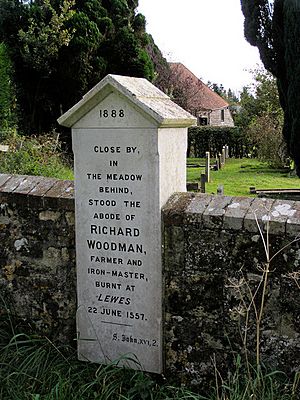Richard Woodman (martyr) facts for kids
Richard Woodman (born around 1524 – died June 22, 1557) was a Protestant who died for his beliefs. He was born in Buxted and lived in Warbleton, both in East Sussex, England. He was burned to death in Lewes during a time known as the Marian Persecutions in 1557. People say that a picture by James Henry Hurdis of Woodman being burned helped start the tradition of remembering the Sussex Martyrs.
Contents
Richard Woodman's Life Story
Richard Woodman was born in Buxted, East Sussex, around 1524. He became an ironmaster, which means he owned and ran a business that made iron. His business was quite big, employing about 100 people!
Trouble Begins
Woodman got into trouble during a church service at St Mary the Virgin Church in Warbleton. He was arrested because he argued with the rector (the local priest). Woodman said the rector was teaching the opposite of what he used to say before Queen Mary came to power. This argument showed that Woodman was a Protestant. At the time, a law from 1553 protected preachers from being criticized while they were speaking. Woodman lived very close to the church, and his iron factory was right next to it too.
Time in Prison
Woodman was put in prison and questioned many times by local judges and at court meetings. He refused to promise that he would change his beliefs to match the official church. He spent a total of six months in prison. During this time, he was questioned by important church leaders like the Bishop of Chichester, George Day, and by people sent by Cardinal Pole.
Later, he was sent to a prison in London called the Queen's Bench. He stayed there for a year and a half. Then, a harsh church official named Dr. John Story sent him to the bishop's "coalhouse," which was another prison. While he was there, he was questioned again. But on December 18, 1555, 30 respected people looked into his case and set him free. They couldn't find anything wrong with his beliefs, and it seemed his arrest was not even legal.
Preaching and Re-arrest
Some people thought Woodman had given in to the church's demands. But he wanted to make sure everyone knew he hadn't changed his mind. So, he started preaching around his local area to correct any misunderstandings. This was probably not a very safe thing to do!
Soon, a warrant was issued for his arrest, so Woodman ran away to another country. He came back later, but sadly, his own brother turned him in. Some say this was because they had a money disagreement. Woodman was sent back to the bishop's "coalhouse" and questioned again. After that, he was moved to another prison called the Marshalsea.
Final Examinations and Execution
On April 27, 1557, John Christopherson, who was going to be the next Bishop of Chichester, questioned Woodman again. But Christopherson wasn't officially a bishop yet, so Woodman couldn't be tried by him. Then, John White, the Bishop of Winchester, questioned Woodman at St George's Church in Southwark. But Bishop White didn't have the authority to judge Woodman either.
Over the next few weeks, Woodman was questioned many more times by White, Christopherson, and another official named William Roper. Together, they finally managed to get Woodman to admit to beliefs that the church considered wrong. Because of this, he was officially removed from the church, a process called excommunication.
Richard Woodman was then taken to Lewes. On June 22, 1557, he was burned to death in front of a building called the Star Inn (which is now the Lewes Town Hall). Nine other people were also burned with him that day. Their names were George Stevens, Alexander Hosman, William Mainard, Thomasina Wood, Margery Morris, James Morris, Denis Burges, Ann Ashdon, and Mary Groves. This was the largest group of people burned at one time in England. It was meant to scare others into following the official church rules.
Richard Woodman's Legacy
Richard Woodman's death is remembered with a special memorial in his local churchyard. He and the other martyrs are also celebrated during the Bonfire Night celebrations, which are very special in Sussex.
In the mid-1800s, a writer named M. A. Lower published a book called Sussex Martyrs. This book helped people remember the martyrs, whose stories had mostly been forgotten. Lower felt that some church leaders were calling the Protestant Reformation and the deaths of these people "a mistake." After his book came out, "anti-Catholic" protests started happening every year around November 5th. In 1868, someone dressed as the "Bishop of Lewes" warned Protestants about the Catholic threat. The next year, a dummy of the pope was even blown up with gunpowder!


